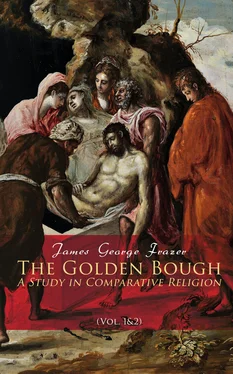There is a priestly king to the north of Zengwih in Burma, revered by the Sotih as the highest spiritual and temporal authority, into whose house no weapon or cutting instrument may be brought.601 This rule may perhaps be explained by a custom observed by various peoples after a death; they refrain from the use of sharp instruments so long as the ghost of the deceased is supposed to be near, lest they should wound it. Thus after a death the Roumanians of Transylvania are careful not to leave a knife lying with the sharp edge uppermost as long as the corpse remains in the house, “or else the soul will be forced to ride on the blade.”602 For seven days after a death, the corpse being still in the house, the Chinese abstain from the use of knives and needles, and even of chopsticks, eating their food with their fingers.603 Amongst the Innuit (Eskimos) of Alaska for four days after a death the women in the village do no sewing, and for five days the men do not cut wood with an axe.604 On the third, sixth, ninth, and fortieth days after the funeral the old Prussians and Lithuanians used to prepare a meal, to which, standing at the door, they invited the soul of the deceased. At these meals they sat silent round the table and used no knives, and the women who served up the food were also without knives. If any morsels fell from the table they were left lying there for the lonely souls that had no living relations or friends to feed them. When the meal was over the priest took a broom and swept the souls out of the house, saying, “Dear souls, ye have eaten and drunk. Go forth, go forth.”605 In cutting the nails and combing the hair of a dead prince in South Celebes only the back of the knife and of the comb may be used.606 The Germans say that a knife should not be left edge upwards, because God and the spirits dwell there, or because it will cut the face of God and the angels.607 We can now understand why no cutting instrument may be taken into the house of the Burmese pontiff. Like so many priestly kings, he is probably regarded as divine, and it is therefore right that his sacred spirit should not be exposed to the risk of being cut or wounded whenever it quits his body to hover invisible in the air or to fly on some distant mission.
We have seen that the Flamen Dialis was forbidden to touch or even name raw flesh.608 In the Pelew Islands when a raid has been made on a village and a head carried off, the relations of the slain man are tabooed and have to submit to certain observances in order to escape the wrath of his ghost. They are shut up in the house, touch no raw flesh, and chew beetel over which an incantation has been uttered by the exorcist. After this the ghost of the slaughtered man goes away to the enemy's country in pursuit of his murderer.609 The taboo is probably based on the common belief that the soul or spirit of the animal is in the blood. As tabooed persons are believed to be in a perilous state—for example, the relations of the slain man are liable to the attacks of his indignant ghost—it is especially necessary to isolate them from contact with spirits; hence the prohibition to touch raw meat. But as usual the taboo is only the special enforcement in particular circumstances of a general rule; in other words, its observance is particularly enjoined in circumstances which are supposed especially to call for its application, but apart from such special circumstances the prohibition is also observed, though less strictly, as an ordinary rule of life. Thus some of the Esthonians will not taste blood because they believe that it contains the animal's soul, which would enter the body of the person who tasted the blood.610 Some Indian tribes of North America, “through a strong principle of religion, abstain in the strictest manner from eating the blood of any animal, as it contains the life and spirit of the beast.” These Indians “commonly pull their new-killed venison (before they dress it) several times through the smoke and flame of the fire, both by the way of a sacrifice and to consume the blood, life, or animal spirits of the beast, which with them would be a most horrid abomination to eat.”611 Many of the Slave, Hare, and Dogrib Indians scruple to taste the blood of game; hunters of the former tribes collect the blood in the animal's paunch and bury it in the snow.612 Jewish hunters poured out the blood of the game they had killed and covered it up with dust. They would not taste the blood, believing that the soul or life of the animal was in the blood, or actually was the blood.613 The same belief was held by the Romans,614 and is shared by the Arabs,615 and by some of the Papuan tribes of New Guinea.616
It is a common rule that royal blood must not be shed upon the ground. Hence when a king or one of his family is to be put to death a mode of execution is devised by which the royal blood shall not be spilt upon the earth. About the year 1688 the generalissimo of the army rebelled against the King of Siam and put him to death “after the manner of royal criminals, or as princes of the blood are treated when convicted of capital crimes, which is by putting them into a large iron caldron, and pounding them to pieces with wooden pestles, because none of their royal blood must be spilt on the ground, it being, by their religion, thought great impiety to contaminate the divine blood by mixing it with earth.”617 Other Siamese modes of executing a royal person are starvation, suffocation, stretching him on a scarlet cloth and thrusting a billet of odoriferous “saunders wood” into his stomach,618 or lastly, sewing him up in a leather sack with a large stone and throwing him into the river; sometimes the sufferer's neck is broken with sandal-wood clubs before he is thrown into the water.619 When Kublai Khan defeated and took his uncle Nayan, who had rebelled against him, he caused Nayan to be put to death by being wrapt in a carpet and tossed to and fro till he died, “because he would not have the blood of his Line Imperial spilt upon the ground or exposed in the eye of Heaven and before the Sun.”620 “Friar Ricold mentions the Tartar maxim: ‘One Khan will put another to death to get possession of the throne, but he takes great care that the blood be not spilt. For they say that it is highly improper that the blood of the Great Khan should be spilt upon the ground; so they cause the victim to be smothered somehow or other.’ The like feeling prevails at the court of Burma, where a peculiar mode of execution without bloodshed is reserved for princes of the blood.”621 In Tonquin the ordinary mode of execution is beheading, but persons of the blood royal are strangled.622 In Ashantee the blood of none of the royal family may be shed; if one of them is guilty of a great crime he is drowned in the river Dah.623 In Madagascar the blood of nobles might not be shed; hence when four Christians of that class were to be executed they were burned alive.624 When a young king of Uganda comes of age all his brothers are burnt except two or three, who are preserved to keep up the succession.625 The reluctance to shed royal blood seems to be only a particular case of a general reluctance to shed blood or at least to allow it to fall on the ground. Marco Polo tells us that in his day persons found on the streets of Cambaluc (Pekin) at unseasonable hours were arrested, and if found guilty of a misdemeanour were beaten with a stick. “Under this punishment people sometimes die, but they adopt it in order to eschew bloodshed, for their Bacsis say that it is an evil thing to shed man's blood.”626 When Captain Christian was shot by the Manx Government at the Restoration in 1660, the spot on which he stood was covered with white blankets, that his blood might not fall on the ground.627 Amongst some primitive peoples, when the blood of a tribesman has to be shed it is not suffered to fall upon the ground, but is received upon the bodies of his fellow tribesmen. Thus in some Australian tribes boys who are being circumcised are laid on a platform, formed by the living bodies of the tribesmen;628 and when a boy's tooth is knocked out as an initiatory ceremony, he is seated on the shoulders of a man, on whose breast the blood flows and may not be wiped away.629 When Australian blacks bleed each other as a cure for headache, and so on, they are very careful not to spill any of the blood on the ground, but sprinkle it on each other.630 We have already seen that in the Australian ceremony for making rain the blood which is supposed to imitate the rain is received upon the bodies of the tribesmen.631 In South Celebes at child-birth a female slave stands under the house (the houses being raised on posts above the ground) and receives in a basin on her head the blood which trickles through the bamboo floor.632 The unwillingness to shed blood is extended by some peoples to the blood of animals. When the Wanika in Eastern Africa kill their cattle for food, “they either stone or beat the animal to death, so as not to shed the blood.”633 Amongst the Damaras cattle killed for food are suffocated, but when sacrificed they are speared to death.634 But like most pastoral tribes in Africa, both the Wanika and Damaras very seldom kill their cattle, which are indeed commonly invested with a kind of sanctity.635 In killing an animal for food the Easter Islanders do not shed its blood, but stun it or suffocate it in smoke.636 The explanation of the reluctance to shed blood on the ground is probably to be found in the belief that the soul is in the blood, and that therefore any ground on which it may fall necessarily becomes taboo or sacred. In New Zealand anything upon which even a drop of a high chief's blood chances to fall becomes taboo or sacred to him. For instance, a party of natives having come to visit a chief in a fine new canoe, the chief got into it, but in doing so a splinter entered his foot, and the blood trickled on the canoe, which at once became sacred to him. The owner jumped out, dragged the canoe ashore opposite the chief's house, and left it there. Again, a chief in entering a missionary's house knocked his head against a beam, and the blood flowed. The natives said that in former times the house would have belonged to the chief.637 As usually happens with taboos of universal application, the prohibition to spill the blood of a tribesman on the ground applies with peculiar stringency to chiefs and kings, and is observed in their case long after it has ceased to be observed in the case of others.
Читать дальше












